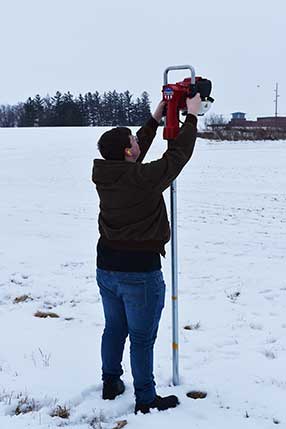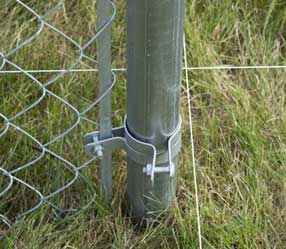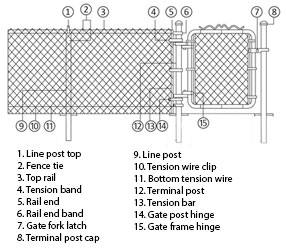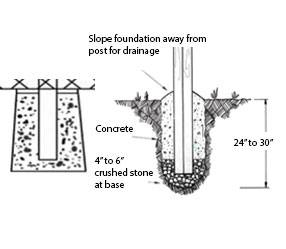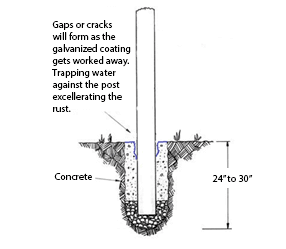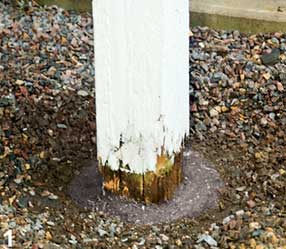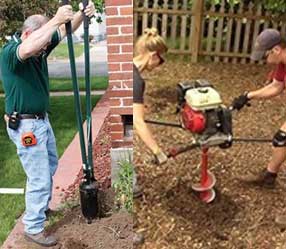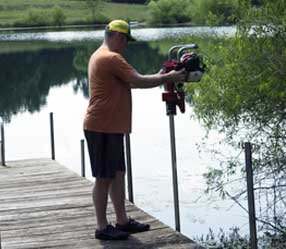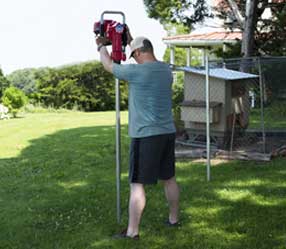
Installation Tips
Easier Fence Installation – Driven Fence Post versus other installation methods
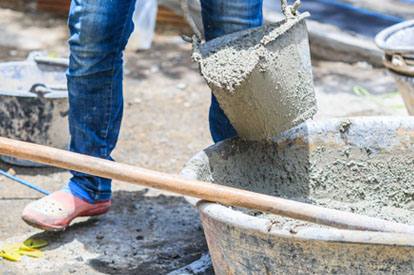
Why the driven post?
“But don’t you have to concrete the post?” This is one of the most common questions we get asked. The answer is “NO” a driven post is as strong or stronger than a concreted post in almost all soil types except rolling sand.
A chart from Northland Fence one of Minnesota’s top fencing companies since 2004 gives the pros and cons of driven posts.
CEMENTED POSTS
Source: www.northlandfence.com/why-drive-fence-posts/
How do we know?
Paramount fence in Orlando Florida says, “Last week, I had the honor of attending the American Fence Association’s (AFA) National Conference In Phoenix Arizona. Concrete or no Concrete was a hot topic. It did not matter if was a fence company from California, North Dakota, Taxes, or New York their answers revolved around three different factors: (1) Geographical Location, (2) Environmental Conditions, and (3) Leverage Ratios versus External Force.”
Rhino Tool Company has been manufacturing and selling post drivers for 45 years. We have been a 40-year member of the American Fence Association as well as the American Rental Association and the American Equipment Manufacturers Association. Our customers range from mom and pop companies to National Fence companies. All of this has contributed to our knowledge of:
- Why to drive fence post
- When to drive fence post
- How to drive fence post
Every Fence job is different in shape, size, material. soil condition will change from location to location, even from one foot to the next. We will discuss a typical residential fence install but these driven post facts apply to all fence jobs, agricultural, commercial, temporary, or security fencing.
The anatomy of a fence
A typical, residential chain-link fence, is designed to support the others, it is a system. The terminal and gate post are typically 2-3/8” diameter and the line post are smaller usually 1-7/8”. The top rail goes between the terminal/gate post giving them support from pulling in. The fabric or chain link is stretched between the terminal posts this puts tension on the terminal post which are supported from moving in that direction by the top rail. Tension bars and tension bands connect that fabric to the terminal post and the fabric is tied to the post and top rail with fence ties. Often a bottom tension wire is installed at the bottom. It is a framework that when installed properly works together for a strong long-lasting fence.
http://bit.ly/chainlinkfenceguide
Why driven posts are superior - Preventing Frost Heave
Frost heave is an issue in many states. How deep you need to install your post depends on how deep the frost gets in your part of the country. Here in Illinois it is about 4’ deep.
How a post is installed with concrete:
- A hole is dug below you frost line in areas that freeze, where frost is not an issue typically 1/3 of the post is concreted into the ground, a 4’ fence would use a 6’ post with 2’ below ground.
- The holes need to be dug with as smooth of sides as possible to prevent the frost from grabbing on.
The holes should be “Belled” on the bottom, the bottom of the hole should be bigger than the top, this is also meant to prevent frost heave.
- The top of the concrete need to me sloping away from the post to not funnel water against the post.
Another method is to use gravel at the bottom of the hole to not trap any moisture against the post. The hole side still need to be a smooth as possible.
- All these techniques are to stop frost from heaving the footing and to stop water from getting trapped against the post.
The smooth sides, the bell shaped holes, or gravel at the bottom, is all done to try to prevent the frost from getting a bite and heaving the footing out of the ground. All expensive and labor intensive steps that are eliminated with a driven fence post.
Ray Stotz, a Certified Fence Professional and owner of Qual line Fence in Wisconsin has been a huge advocate for drive post “Another proper way to set a post is driving a smooth steel post 4 to 6 feet deep. The smoother the sides of the post, the better. Just like with a concrete column, if there is a rough edge for freezing ground to grab the post, it will.”
Source: www.quallinefence.com/fence-school/why-is-my-fence-heaving-out-of-the-ground/
Delayed Rot and Decay
Wooden posts are more susceptible to rot when they are concreted in place. The Wood will naturally expand and contract with moisture and temperature, eventually leaving a small gap between it and the concrete. This small gap collects water and debris giving rot a chance to start, eventually it will eat through even treated post. Installing the post without concrete, driving them, allows the soil to do what it does best, absorb the moisture keeping the post drier prolonging the life of the post.
Steel Post are susceptible to rust, even galvanized and powder coated post will eventually rust if not properly installed or maintained.
Rusting is a result of a process called oxidation. Oxidation takes place when oxygen molecules come in long term contact with certain metals.
The main catalyst for the rusting process is water, iron or steel structures which appear solid but can be easily penetrated by water molecules. Oxygen atoms combine with the atoms of the metal to form a destructive oxide compound. This makes the metal structure brittle.
Driving post instead of pouring them in concrete allows the soil to absorb the water around the post keeping it dry. Concrete draws water to it and over time as a gap or crack begins between the post and concrete it will trap water there increasing the speed at which it will rust.
Faster, easier installation
Installing the post is the most labor-intensive part of putting up a fence. Even in easy soft soil it would take am installer 5-10 min to dig a post hole another few minutes to mix the concrete, pour it in the hole and place and plumb the post. Driving a post in by hand with a hand pounder would still be 4-5 min but you would save all the time mixing an pouring the concrete. A gas, pneumatic or hydraulic post drive could do the job in less than a minute in most soils.
The post must be positioned properly and plumb. This is an area you need to special attention to when you are driving a post, If you do not drive the post in the right position or plumb you will have to pull it out and redo it, that would be pretty hard if it was placed in concrete.
Conclusion
If you want to install a fence that will last a long time, with less labor and time, you will want to drive the post and not concrete them in place. In all climates and soil condition except rolling sand a properly driven post will be easier to install, stronger, and last longer than a concreted post.
Key Takeaways:
- Save time and money on installation by not digging a hole getting rid of the spoils and pouring concrete
- Protect your fence from Frost heave in climates that have frozen ground
- Prolong the life of the post by not trapping water in the concrete footing reducing the likelihood of rot and rust
- Easier maintenance with no concrete footing in your yard that could catch a mower blade if not installed properly or they heave up with frost
- Environment impact is much lower, no concrete to pour, no concrete to dispose of later in life.


